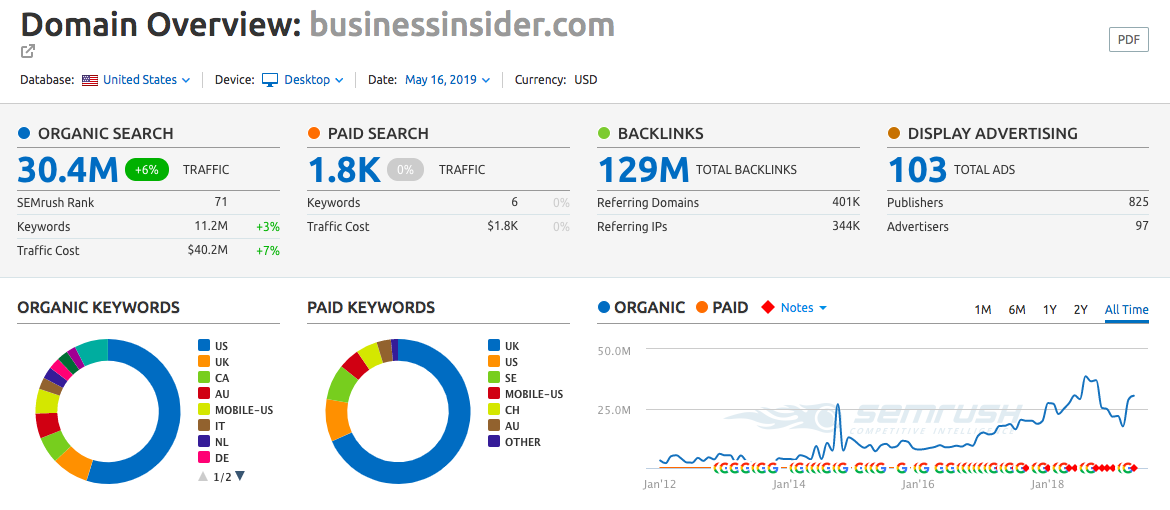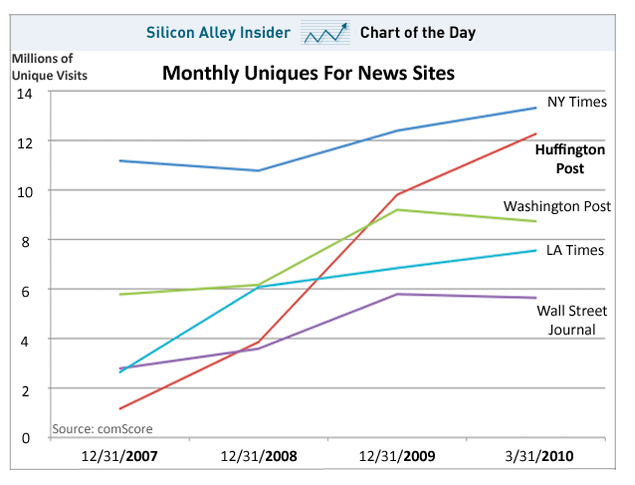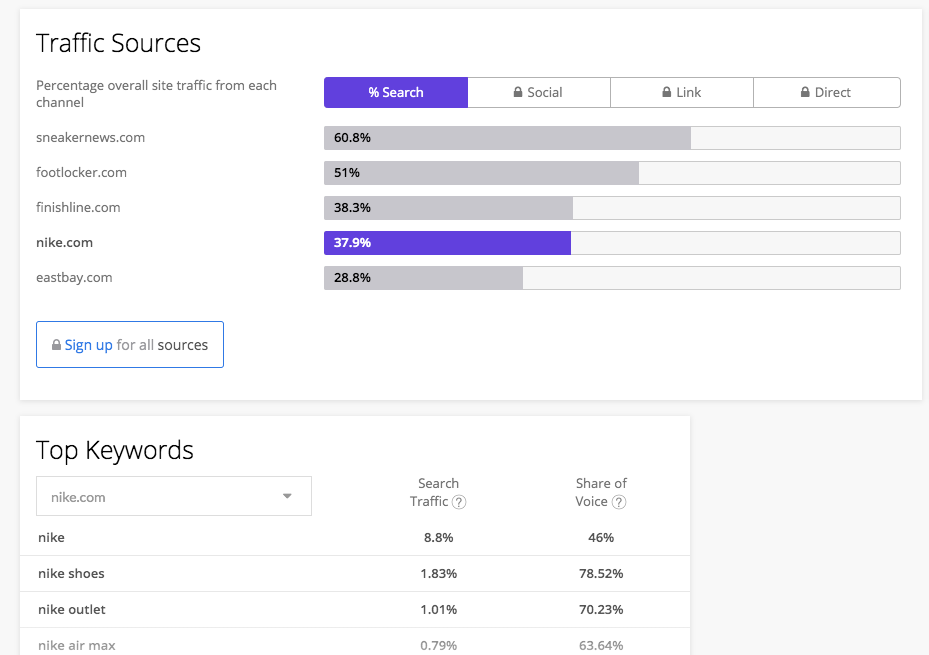All great marketers have this in common: they love hacking.
And no, I don’t mean hacking into someone’s website (don’t be *that guy*).
What I’m referring to is “hacking” another business’s marketing strategy that’s working, reverse-engineering that strategy, and applying those techniques to your own approach.
You’ll feel like a marketing genius and save loads of time compared to building your strategy from scratch.
Why use trial-and-error when you have real traffic success case studies to tell you what’s working already?
If you’re someone that likes to dig into the data and spy on the competition, then you’ll love these five traffic secrets from the most popular blogs. Let’s get hacking.
Estimated monthly visitors: 30.4 million

Business Insider is one of the fastest growing financial, media, and tech blogs in the world.
Generating more than 30 million website visitors per month, there’s no doubt that there’s some golden knowledge to uncover about their content strategy.
In 2011, Business Insider did the unthinkable: they gave the public a peek into their traffic and monetization strategy. They called this reveal the “Full Monty”.
The Secret: Getting the Story First
While Business Insider CEO Henry Blodget actually revealed multiple secrets about the blog’s traffic strategy, the key takeaway was this:
Create great digital content, fast.
The news site was before its time in the fact that it focused primarily on digital content from the beginning.
Not print content. Not broadcasting content.
They knew where their target audience was heading and got ahead of the curve.
Today, the need to create digital content is a no-brainer. So what makes their existing content strategy different?
Timeliness.
Business Insider always gets the inside scoop first. They stay ahead of the latest news stories, are constantly chasing leads, and update their articles with new facts as quickly as possible.
They don’t thrive on evergreen content, and that’s OK.
Their game is getting the story first, attracting the first clicks, and circulating trending content quickly.
How to Hack It
In the article, Blodget states that “‘social’ is not the end-all and be-all for digital news sites.” In reality, their readership is a mix of direct, organic, social, and email traffic.
What this means is that you too can have an ever-present content strategy by creating timely content and circulating it to the right platforms.
While having evergreen content is great, there’s something to be said for creating fresh, “trending” content.
That’s because users not only look for answers to age-old questions, but also for content that is relevant to what’s happening in the world at that moment.
Therefore, you can hack this strategy by creating content that’s of interest to your audience and harnesses the momentum of trending keywords. Google Trends is a great tool for identifying these opportunities.
For example, when GDPR became a hot topic, many tech niche sites and marketers hopped on the bandwagon by creating content like “What Does the GDPR Update Mean for Your Business?” and “10 Tips for Being GDPR Compliant in Your Email Marketing”.
Stay on top of the trends and work that angle that makes the topic relevant to your target audience. Then, push that content out to multiple platforms rather than waiting for the traffic to come to you.
Ride that #trending wave.
Estimated monthly visitors: 16.7 million
Arianna Huffington’s namesake blog was never meant to be a business. Yet, since its start in 2005, the site quickly climbed the ranks to being the 154th most popular blog in the world.
The Huffington Post has become a huge success in terms of web traffic and notoriety – bringing in over 500,000 visitors per day and becoming a household name as a political blog.
However, the mag hasn’t been without its struggles. Huffington herself eventually left the magazine over “burnout” and uneasy profitability.
She has been quoted as saying, “Just in case I get hit by a bus today, let me state this for the informal record: in my last year there, we made about $110 million in revenue, give or take, and we weren’t profitable.”
So, what made Huffington Post a traffic success despite their shaky business model?
The Secret: Publish with a Purpose
The Huffington Post originally started as a political news site to inform the public about important issues in the world. It was the founder’s direct response to the corporate-controlled, money-hungry news sites.
This resonated with people.
There was finally a website that offered unbiased news stories, as well as opinion pieces from both sides of the aisle. It fulfilled the public’s need for real and raw political dialogue.
This resulted in the Huffington Post quickly surpassing existing news sites like the Washington Post, the New York Times, and the Wall Street Journal.

The main lesson to be learned from Huffington Post’s story is that it’s important to publish with a purpose.
Publishing content for traffic’s sake will only get you so far if you don’t take the time to understand your audience and create content that fulfills a need.
How to Hack It
The Huffington Post’s shift from purpose to profit is a rather cautionary tale. If you lose track of what value you aim to provide your audience, burnout is inevitable.
Huffington experienced this when her site quickly grew far beyond what she originally envisioned. It became too much of a business.
Many content creators get into this predicament.
They create content focused on keywords, conversion rates, and cost per click. They forget that traffic and conversions are often proportional to the amount of interest their audience actually has in the content.
The content you create should serve the purpose of fulfilling a need that your audience has. It should provide value, improve their lives in some way, and offer insights that no other website is providing.
Before you create content, ask yourself these questions:
- Have I asked my audience directly what they are interested in reading?
- Do I know their pain points, fears, needs, and desires?
- Do I have the data to support this, or am I assuming this is what they want?
- What is the primary purpose of this content?
- What is the ultimate goal that I want to achieve with this content?
- What action do I want users to take when they read this content?
Don’t veer too far away from the purpose of your content. Focusing on pleasing Google or optimizing for clicks will get you part of the way, but it won’t be enough to keep users interested in and engaging with your content.
Optimizing for conversions really means creating content for humans. Create content that lives and breathes and serves a purpose.
Estimated monthly visitors: 13.8 million
If Business Insider is the king of world news, then TMZ is the drama queen of Hollywood news.
TMZ is known for breaking the biggest stories in celebrity gossip and entertainment.
While TMZ hasn’t graced us with much insight into their traffic stats or strategy, a little detective work reveals a big secret about their success.
The Secret: ‘Tipsters’
As a content creator and writer, I was curious as to where TMZ sources their writers (and how they find the juiciest stories).
A search on their website only uncovered that they hire a few “field reporters” and “researchers”. But, I wondered, who tips them off to the hottest celebrity gossip?
The answer, I discovered, is “tipsters”.
Tipsters are their people “on the ground.” People who go digging for the inside scoop.
These people don’t work directly for TMZ, but instead, are incentivized to offer expert knowledge or reveal sensitive information to the magazine. They typically receive payment or notoriety.
The New York Times reported, “TMZ’s producer revealed that he sometimes negotiated payments with tipsters… he said, ‘We want you to be a source for us again. We want you to trust us.’”
TMZ has therefore created a low-cost, consistent content creation model based on incentivization.
You can do the same.
How to Hack It
The concept of “tipsters” sounds unsurprisingly similar to another type of content strategy: expert-generated content.
This can take the form of expert interviews, roundup posts, webinars, podcasts, guest posts, and video content.
The idea is to incentivize industry experts to create content for your site, tip you off to new content ideas, and then share your content to their own audiences.
It’s an “I scratch your back, you scratch mine” model for creating fresh, interesting content without the costs of creating it yourself or hiring writers. The payoff for your “tipsters” is exposure, traffic, backlinks, and authority-building.
You can hack this strategy for your own site by inviting experts to create content for you or to participate in a piece of content you are creating.
Open your site up to guest posts, video contributions, exclusive interviews, or expert quotes.
This will help you create a greater volume of content and broaden your reach.
A little ego boost can go a long way.
Estimated monthly visitors: 11.6 million
The Verge is a “Jack of all trades” publication that covers everything from entertainment to tech to science to product reviews.
Launched in 2011, they publish a combination of new articles, guidebooks, podcasts, and feature interviews.
There’s a common saying in marketing: “The riches are in the niches.”
Since The Verge doesn’t have a clear niche, it begs the question: how do they get their content to rank and generate so much traffic?
The Secret: Referral Websites
An Alexa audit of theverge.com revealed that the blog’s primary traffic sources are sites like sneakernews.com, footlocker.com, finishline.com, and nike.com. All of these are sites those of major shoe and athletic apparel companies.

What this tells us is that the majority of The Verge’s traffic is coming in via referral sites. The sites primarily reference the blog’s product reviews.
Not only do these referral sites send traffic to The Verge via external links from their own content, but they boost the blog’s authority as well.
Nike.com alone attracts over 40 million visitors per month and has a Moz domain authority score of 89. No doubt that The Verge is picking up a bit of that juice.
How to Hack It
The Verge’s content strategy reveals a great opportunity for websites to generate traffic from sources beyond organic search. This is especially the case for affiliate websites.
If the purpose of your website is to promote affiliate products, then your traffic strategy will benefit greatly from you creating content that draws in attention from other industry-leading websites.
Not only will users venturing from these websites be interested in your content and products (making them more likely to convert), but high authority backlinks could give your site that added SEO boost.
What this looks like it creating content that provides value to your preferred referral sites – content that:
- Reviews their products.
- Offers comparisons of their products over competitors.
- References other articles on their website.
By publishing content that provides value to other sites in your industry, you have the opportunity to create a whole additional traffic source beyond organic search.
Estimated monthly visitors: 3.5 million
Lifehacker’s tagline “Do everything better” is a bold assertion that users can hack their way to success in life. (Ironic, perhaps, that we are doing the same here when it comes to your content strategy.)
The blog offers helpful, often time-saving and money-saving tips for how to work better, live longer, and lead a happier life.
Many of their articles are bite-sized posts that reveal one or two hacks or a bulleted list of tips.
The Secret: Community-Generated Content
Fortunately, I was able to get the inside scoop from a previous Lifehacker writer who was happy to give insight into the blog’s content strategy.
Copywriter Tori Reid describes how the success of Lifehacker is a result of the site letting their audience feed them the content ideas:
“What people don’t realize about the Gawker Empire as a whole is that it’s a community-driven platform from head to toe. Readers aren’t just readers, they’re active contributors who create their own profiles and have their own sub-blog space on the domain.
At Lifehacker specifically, we were required to stay online 30 minutes after posting just to interact with the commenters and drive up engagement. And to boot, we were actively encouraged to pull content ideas directly from the community itself.
Lifehacker didn’t become a top-ranking blog from obsessing over content, or even serving Google. Lifehacker became a top-ranking blog because of its relentless obsession with serving its community – which is all the Google algorithm wants bloggers to do anyway.”
Lifehacker needs not to rely on keywords to come up with click-worthy content ideas. They generate a treasure trove of blog topics by simply asking their audience what they want to read.
Is it really that easy?
How to Hack It
One of the most common questions I get as an SEO content writer is “How do I come up with blog post ideas?”
Despite the fact that countless SEO tools and idea-generating tools exist, website owners still have a difficult time coming up with topics that draw in traffic and keep their audience engaged.
That’s because we – yes, myself included – often overcomplicate the process.
We try to guess what our readers want. We dig into the search data to see which keywords get the most volume. We try to imitate the content our competitors are creating.
Really, your readers will often tell you exactly what they want. They are most likely to do this if you ask.
If you have an existing presence on social media, you can easily reach out to your target audience to get their input on what topics they are interested in.
You can also source ideas from the comments section, email responses, reviews, or feedback from past clients or customers.
Don’t overcomplicate.
Start with your audience and generate a list of topics that they want to read about. Then, use SEO tools to identify the appropriate keywords to target in that content.
Further, if you expect your readers to be engaged, you need to be get engaged as well.
Respond to comments, ask questions, ask for feedback, and be receptive to their ideas. You can even open your platform up to user-contributed content.
Get your content straight from the horse’s mouth? How’s that for a content hack? Thanks, Lifehacker!
More Resources:
Image Credits
All screenshots taken by author, May 2019